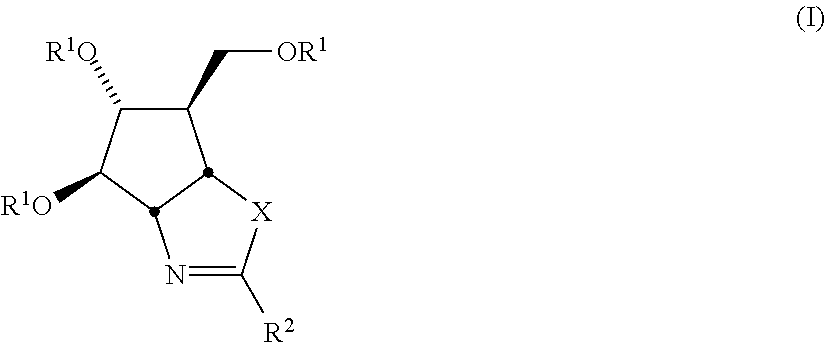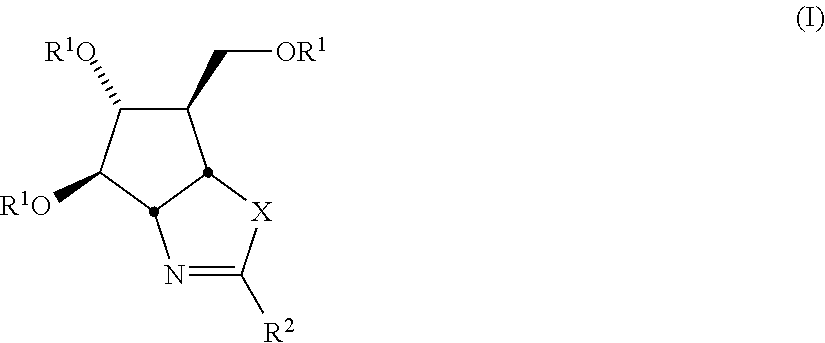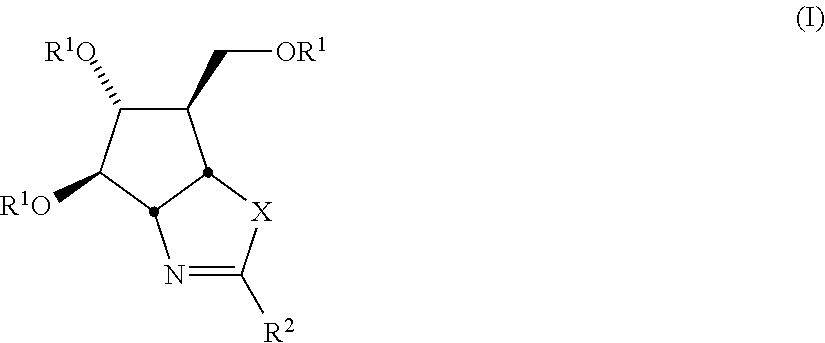Selective Glycosidase Inhibitors and Uses Thereof
a glycosidase inhibitor and selective technology, applied in the field of selective glycosidase inhibitors, can solve the problems of affecting the activity of tau, and affecting the normal function of tau, so as to increase the level of o-glcnac
- Summary
- Abstract
- Description
- Claims
- Application Information
AI Technical Summary
Benefits of technology
Problems solved by technology
Method used
Image
Examples
example 1
[0146]Compounds 1 and 2 (allosamizoline) are prepared via known synthetic methods.121-131 For example, following the synthetic route of Trost et al.126 (Scheme 1), reaction of the diol A with 2 equiv. TsNCO followed by catalytic palladium provides the cyclic carbamate B in 96% yield. Removal of the tosyl group with sodium in napthalene gives C in 91% yield, which is then converted in quantitative yield to the amino oxazoline D by reaction with freshly-distilled methyl triflate followed by dimethyl amine. Dihydroxylation of the double bond in D using trifluroperacetic acid in TFA then warming with aqueous TFA, followed by benzyl deprotection with hydrogenolysis provides allosamizoline 2 in 67% yield. Numerous alternative synthetic routes are available for the preparation of 2, as described in the references cited herein.121-131
example 2
[0147]Compounds of the invention having general structure F are prepared according to the sequence described in Scheme 2. Thus, starting from the intermediate C,126 treatment with methyl triflate followed by the requisite primary or secondary amine (analagous to the procedure described by Trost et al.126) provides the amino oxazolines E. Dihydroxylation of these materials followed by deprotection using the same conditions described in Scheme 1 provides the desired products F.
example 3
[0148]Compounds of the invention having general structure K are prepared according to the sequence described in Scheme 3. Thus, starting from the intermediate G,132 treatment with the appropriate isothiocyanate provides the ureas H. Mesylation of the alcohol function in H provides intermediates I. Treatment of these compounds with potassium iodide in acetone converts the mesylate to an iodo function with inversion of stereochemistry; under the reaction conditions, the thiourea cyclizes onto the iodo group to give intermediates J. Deprotection of the TBDMS group in these materials with TBAF, followed by benzyl deprotection using hydrogenolysis furnishes the desired products K.
PUM
| Property | Measurement | Unit |
|---|---|---|
| Mass | aaaaa | aaaaa |
| Electrical conductance | aaaaa | aaaaa |
| Electrical conductance | aaaaa | aaaaa |
Abstract
Description
Claims
Application Information
 Login to View More
Login to View More - R&D
- Intellectual Property
- Life Sciences
- Materials
- Tech Scout
- Unparalleled Data Quality
- Higher Quality Content
- 60% Fewer Hallucinations
Browse by: Latest US Patents, China's latest patents, Technical Efficacy Thesaurus, Application Domain, Technology Topic, Popular Technical Reports.
© 2025 PatSnap. All rights reserved.Legal|Privacy policy|Modern Slavery Act Transparency Statement|Sitemap|About US| Contact US: help@patsnap.com



